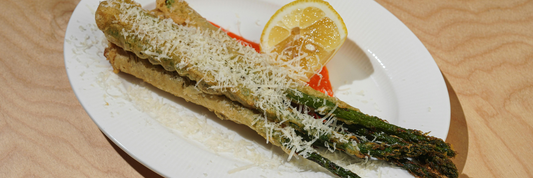Unlike conventional to go box, vented takeout containers are a type of packaging specifically designed to suit many types of food. Today's article delves into the key features of these containers and explores whether they are worth using.
- Why do Coffee Bags Have Vents? The Mechanics of Coffee Bag Vents
- What Are Advantages of Sugarcane Clamshell Containers?
- Which Food Business Will Need Flexible Packaging?
Vented Takeout Containers Overview
Before understanding how vented takeout containers useful for business, let’s learn more about common types of vented takout containers and how the vents works.
Common Types of Vented Takeout Containers
Vented takeout containers are a type of food container that has been designed with small holes or vents to allow for air circulation. There are 3 common types of vented takeout containers, including:
- Permanent Venting: This refers to containers that have built-in vents that are always open. These vents are typically small holes or slits in the lid or sides of the container. They allow for continuous air circulation, regardless of how the container is stored or used.
- Optional Venting: This describes containers that have a mechanism to control ventilation. This could be a lid with a vent that can be opened or closed, or a container with flaps or covers over the vents. This allows users to choose whether or not to have ventilation depending on the food they are storing.
- Venting While Stacked: This is a specific concern for takeout containers that are designed to be stacked on top of each other. Some permanent vent designs might not function well when stacked, as the top container's vents could be blocked by the bottom container. Ideally, a vented container should still allow for air circulation even when stacked.
How Vented Take-out Container Works
The vents play an important roles to keep the food from moisture. Here is how the vents work:
- Steam escapes: the hot food releases steam as it cools
- Vents take action: The steam travels towards the cooler lids, but instead of condensing, it escapes through the vents.
- Moisture controlled: With the steam gone, there’s less condensation on the lid, preventing water droplets from dripping onto the food.
Overall, vented takeout containers can be divided into 3 types including permanent venting, optional venting and venting while stacked. With the vent, food can avoid from moisture and soggyness.
Advantages and Disadvantages of Vented Take-out Containers
As mentioned above, vents keep food away from moisture. This bring many benefits for business. But still there are some disadvantages. We will discuss about this in this section.
Advantages of Vented Takeout Containers
Vented takeout containers offer several benefits that can be attractive to businesses in the food service industry:
- Improved Customer Satisfaction: Vented containers help to ensure food arrives at its destination fresh and delicious. This translates to happier customers who are more likely to return for repeat business and leave positive reviews.
- Reduced Food Waste: Soggy, wilted, or overcooked food often gets thrown away by customers. Vented containers help prevent this by maintaining food texture and quality, leading to less food waste and potentially lower costs.
- Versatility: Vented containers are suitable for a wide variety of takeout items, from hot and greasy foods like fried chicken to fresh salads and sandwiches. This allows businesses to use one type of container for many different dishes, simplifying inventory management and potentially reducing costs.
- Improved Reheating: Vented containers allow steam to escape during reheating in the microwave. This prevents food from becoming mushy or overcooked, leading to a better reheating experience for customers.
- Branding Opportunity: Vented containers can be customized with your business logo or branding elements. This provides additional brand exposure to customers and can help with brand recognition.
- Reduced Spoilage: By preventing condensation, vented containers can help extend the shelf life of some foods, reducing spoilage and potentially lowering food costs.
- Efficiency: Some vented containers are designed for easy stacking, which can save space during storage and transportation.
Beside of many advantages, however, there are still some disadvanatges.

Disadvantages of Vented Takeout Containers
While vented takeout containers offer many advantages, there are also some drawbacks to consider for businesses in the food service industry:
- Potential for Drying Out Food: Excessive air circulation through vents can dry out some foods, especially delicate items like pastries, cooked vegetables, or certain cuts of meat. This can negatively impact the quality and customer experience.
- Reduced Temperature Retention: Vents allow some heat to escape, which could be a concern for keeping hot foods warm over longer delivery times. This might necessitate additional packaging like heat wraps or require informing customers about the optimal consumption window.
- Higher Cost: Vented containers, especially those with advanced features like leakproof designs or optional venting mechanisms, might be more expensive than basic sealed containers. This needs to be factored into overall cost analysis.
- Leak Risk: Depending on the design and quality of the container, vents might create weak points that could increase the risk of leaks or spills, especially for liquid or saucy foods. This could lead to customer dissatisfaction and potential damage to other items during delivery.
What Type of Food Suitable with Vented Containers
Vented take-out containers are particularly well-suited for foods that are susceptible to negative effects from trapped moisture and steam, including:
Hot and Crispy Foods:
- French Fries: Venting prevents condensation from forming, keeping fries crisp and delicious.
- Fried Chicken: Vents allow steam to escape, preventing the chicken from becoming soggy and greasy.
- Pizza: Venting helps prevent the crust from becoming soggy and the cheese from getting rubbery.
- Onion Rings: Similar to fries, venting keeps onion rings crispy and flavorful.
- Tempura: Vented containers help maintain the light and crispy texture of tempura dishes.
Other Foods That Benefit from Venting:
- Salads: Venting prevents greens from wilting and becoming soggy from dressing.
- Sandwiches: Vents allow steam to escape, preventing bread from becoming soggy from fillings.
- Burgers: Similar to sandwiches, venting helps maintain the texture of burger buns.
- Pastries (with Caution): While some pastries can benefit from a small amount of venting to prevent condensation, excessive venting can dry them out. Opt for containers with minimal or adjustable venting for pastries.
Overall, vented takeout containers are suitable with a wide range of food. This helps many types of business in the food service industry. Let’s explore if your business should use them in the next section.
Should Your Business Choose Vented Takeout Containers?
Suitable with a wide range of food, here are list of business should chóoe vented takeout food:
- Restaurants with Takeout & Delivery: Vented containers are a great option for restaurants with a high volume of takeout and delivery orders. They help maintain food quality during transport, leading to happier customers and potentially more repeat business.
- Businesses Offering Hot & Crispy Foods: Fast food restaurants, pizzerias, fried chicken shops, and businesses specializing in crispy or tempura dishes can greatly benefit from vented containers to prevent sogginess and maintain texture.
- Salad & Sandwich Shops: Vented containers help prevent bread from becoming soggy and greens from wilting, ensuring fresh and delicious salads and sandwiches for takeout and delivery.
Conclusion
In conclusion, vented takeout containers are heroes for fresh takeout. They prevent condensation and maintain food quality, leading to happy customers and potentially booming business. But they're not a magic bullet. Consider your menu, delivery times, and customers to see if vented containers are your best bet. For hot, crispy, and moisture-sensitive foods, they can be a game-changer.




